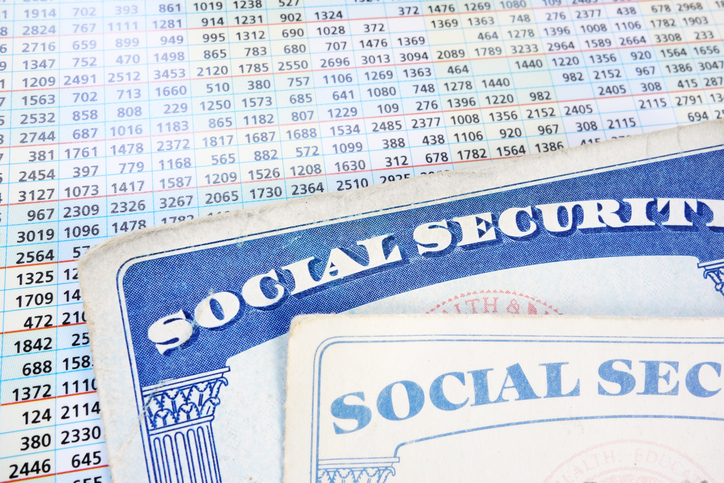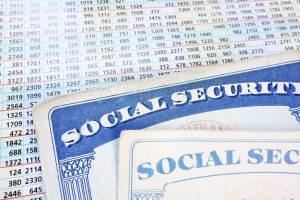Have You Reviewed Your Earnings Record?
June 29, 2017
Financial Planning


Social Security cards and a sheet of budget numbers
There are many facets of exploration into the Social Security System and the focus is often on when to collect benefits and how much the benefits will be. There are, however, other pieces of Social Security to be reviewed and discussed prior to that time period. In this piece, we’ll focus on one of those: your earnings record.
TEXT
What is your earnings record?
Your earnings record is where the Social Security Administration (SSA) tracks your annual earnings (for Social Security and Medicare purposes) and is used to determine your eligibility for Social Security benefits and the level at which they will be paid to you in retirement.
Your earnings record is where the Social Security Administration (SSA) tracks your annual earnings (for Social Security and Medicare purposes) and is used to determine your eligibility for Social Security benefits and the level at which they will be paid to you in retirement.
TEXT
What is included on the record?
After each year you work and pay taxes into the Social Security System, you will receive a Form W-2 detailing wages for the prior year. The W-2 includes many boxes with information, one of them being a ‘Social Security Wages’ figure that reflects the income subject to Social Security taxes. The Social Security program, officially titled “Old-Age, Survivors, and Disability Insurance (OASDI)”, puts limits on the amount of your earnings that are subject to taxation in a given year. This limit changes each year with changes in the national average wage index and is called the ‘contribution and benefit base’. For 2017 it’s $127,200. A historical list of the contribution and benefit base can be found here.
After each year you work and pay taxes into the Social Security System, you will receive a Form W-2 detailing wages for the prior year. The W-2 includes many boxes with information, one of them being a ‘Social Security Wages’ figure that reflects the income subject to Social Security taxes. The Social Security program, officially titled “Old-Age, Survivors, and Disability Insurance (OASDI)”, puts limits on the amount of your earnings that are subject to taxation in a given year. This limit changes each year with changes in the national average wage index and is called the ‘contribution and benefit base’. For 2017 it’s $127,200. A historical list of the contribution and benefit base can be found here.
TEXT
So, each year, your earnings are reported to the SSA and added to your earnings record. If your earnings are above the base, only the base amount will show on your earnings record (and you only would have paid Social Security taxes on that base amount). These figures continue to be reported and collected on your earnings record each year.
TEXT
How is the record used?
After working and paying Social Security taxes for ten years (or 40 quarters of Social Security ‘credits’), you become eligible for benefits.
TEXT
The amount of the benefit you receive at retirement is based on your highest 35 years of income. Per the Social Security Administration’s process, the SSA will look at your earnings figures on your record and index the amounts to reflect changes in wage levels during your working years and ensure your future benefits reflect the changes in standard of living during that timeframe. This indexed amount is known as your Average Indexed Monthly Earnings (AIME).
TEXT
The AIME is then used in a formula that determines your Primary Insurance Amount (PIA), or the amount you can expect to receive at Full Retirement Age. This figure is shown on your Social Security Statement and adjusted if you decide to take benefits at different ages (reduced if earlier than Full Retirement Age (FRA), increased if you wait until after FRA). If you’re looking for your Social Security statements, we’ll note that these are rarely mailed anymore, and are easily accessible on your mySocialSecurity account.
TEXT
Why does the record matter?
As you can see, the earnings record is the base used to determine future benefits and thus it’s imperative the record is correct to ensure you get all the benefits you’ve worked hard to earn!
TEXT
How do I review my record?
The first step to reviewing your record is to create your online account. To do so you’ll need a valid email address, a Social Security number, and a U.S. mailing address. Once you have that information, visit this link and follow the steps to create your account.
TEXT
When you’ve created and accessed the account, you will see a link to your Earnings Record. Click that link and review the record. If you see $0 earnings years when you know you had earnings, or figures that don’t quite match what you would expect to see, we recommend you do a deeper review.
TEXT
What if I find an error?
First, you’ll need to find proof of the correct earnings figure. This information can be found on a W-2, earnings statement or tax return. Even if you don’t have proof in one of these forms, write down everything you can remember about the earnings – where you worked, when, how much you earned, name and social security number used, etc. Then call the Social Security Administration at 1-800-772-1213 and work with them to get your record corrected.
TEXT
It’s very important to contact the SSA as soon as you notice an error as it can take time to correct your record depending on the information you have proving the difference.
TEXT
Then what?
Let us know if you have questions or find an error. We will help you in any way we can.
TEXT
Once you’ve confirmed your earnings record is accurate (or fixed any existing errors), we suggest the following next steps:
- Review your earnings record each year to ensure your earnings continue to be reported accurately (or so
you can correct them in a timely manner). - Send us a copy of your most recent Social Security statement via one of these secure methods (as it includes sensitive personal information).
- We’ll save the statement for our records and prepare a Social Security Analysis to review your filing options and we’ll discuss with you our recommendation as you near retirement age.
In summary, your earnings record is only one aspect of Social Security, and it’s a big one. It is used to determine a potentially important aspect of your retirement plan and it’s important that the record is accurate and reviewed frequently. In this piece, we shared how and why to do this review. And what to do if you find an error.
TEXT
As always, we’re happy to answer additional questions and discuss any and all aspects of Social Security with you at any time.
